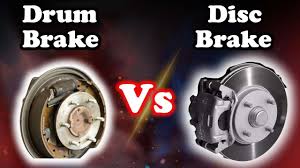
Understanding your vehicle’s braking system is essential—not just for maintenance, but for making smart upgrade decisions. The two primary types of braking systems are drum brakes and disc brakes, and each has unique advantages and limitations. Whether you’re outfitting a performance vehicle or just want safer, more consistent stops, knowing the difference helps you get the most from your investment. If you’re driving a Honda Accord, upgrading to premium options like Honda Accord brake rotor can deliver a noticeable improvement in stopping performance.
Know What’s Under Your Car and Why It Matters
Drum brakes have been around for over a century and are commonly found on the rear wheels of many older or economy-focused vehicles. They operate by pressing brake shoes outward against the inside of a spinning drum attached to the wheel. While cost-effective and reliable in low-speed situations, drum brakes tend to overheat quickly, which reduces their effectiveness under heavy or prolonged braking.
Disc brakes, on the other hand, are now standard in most modern vehicles—especially on the front wheels, which handle the majority of braking force. These systems use calipers to press brake pads against a rotor, creating more consistent friction and better heat dissipation. Disc brakes offer improved stopping power, reduced brake fade, and faster recovery after repeated braking.
For drivers seeking durability and better heat resistance, disc brakes are clearly the superior option. They are less affected by water and debris, making them more reliable in wet or muddy conditions. Additionally, disc systems are easier to inspect and maintain, with pads that are simpler to replace and wear indicators that help prevent unexpected failures.
When choosing upgrades, your choice in brake pads plays a significant role. Options like Duralast Honda Accord brake pads are engineered for reliability and everyday performance, giving you a balance of longevity and stopping strength. These pads are often paired with high-quality rotors to form a balanced system that resists fade and handles heat efficiently.
Compare Braking Systems for Smarter Upgrades
When comparing drum and disc brakes for upgrade potential, it’s not just about the hardware—it’s about your driving style and needs. If your vehicle still uses drum brakes on the rear, upgrading to disc brakes (if compatible) can enhance braking consistency and improve overall vehicle handling. This is especially important for those who regularly carry heavy loads or live in mountainous regions.
Disc brakes also offer better customization and performance tuning options. From slotted rotors to ceramic brake pads, you can tailor your setup to your exact driving habits and performance goals. This level of control simply isn’t available with traditional drum systems.
For performance-focused drivers, options like Powerstop Honda Accord brake rotors are ideal. These pads are designed for higher temperatures and more aggressive braking conditions, offering a level of stopping power that stock components can’t match. They’re perfect for those who want to push their Accord to the limit while maintaining safety and control.
In summary, understanding the key differences between drum and disc braking systems is crucial when planning any brake-related upgrades. Disc brakes deliver better performance, easier maintenance, and superior heat management, making them the preferred choice for most modern vehicles. And with trusted brands like Baer, Duralast, and Powerstop available at AutoZone, upgrading your Honda Accord’s braking system has never been easier or more effective. Make the smart choice for your ride—and stop with confidence every time.






